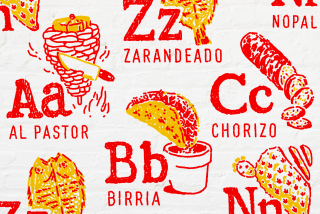Glossary of Jamaica Food Terms
- Share via
The lure of the exotic cuisine of the Caribbean in general, and Jamaica in particular, has popularized products from the region as more home cooks begin experimenting with some of the island’s popular dishes. The following glossary of Jamaican ingredients should help novices become acquainted with Jamaican cuisine. These and other island confections may be found at Grand Central Market, 315 S. Broadway; Stone’s Market, 6700 S. Crenshaw Blvd; Allen’s Belizian and West Indies Market, 5317 S. Normandie Ave., and some of the Latino markets around the Southland.
Ackee--This bland fruit with a woody shell is about the size of a peach and is currently an illegal import because it can be poisonous if eaten when overripe or not ripe enough. But on native soil it bursts open to reveal shiny black seeds and three segments of edible flesh, and is prepared as a vegetable. It’s usually served to contrast the salty flavor of cod or as a complement to scrambled eggs.
Blue Mountain Coffee--Considered by gourmets as the Champagne of coffees, the beans are grown in a geographically prime area on the eastern slopes of the Blue Mountain range.
Breadfruit--Large green fruit with potato-like flesh. Can replace any starchy vegetable. Must be cooked before eating.
Callaloo--Similar to spinach, used in stews and soups.
Chu Chu--Tropical squash with firm flesh, like chayote.
Coconut--Grated pulp and milk used for baking fowl, fish and roast meats plus desserts.
Conch--A tough sea creature that must be marinated to tenderness before use.
Escallions--Green onions.
Ground Pimento--Not to be confused with “pimiento,” pimento is what Jamaicans call allspice.
Guinep--Small fruit with thin green skin like grapes. Grows in bunches and is most widely used in desserts.
Guava--Sweet oval-shaped fruit, to be eaten raw or stewed; often used for jelly. Flesh varies from white to deep pink.
Jamaican Nutmeg--Brown oval seed, covered with a thin brown shell with red lacy network, which is ground and used as seasoning.
Jamaican Chocolate--Touted as having a “distinctive flavor” that comes from Jamaica-grown cocoa beans.
Jamaican Ginger Beer--Not beer as we know it. The juice extracted from ginger root is combined with water, lemon juice and sugar, allowed to stand a few days and then used as a potent base that can be served alone or added to juices--particularly pineapple--for a refreshing drink.
Jerk Chicken or Pork--Chicken and pork pieces heavily seasoned with garlic, green onion, pimento (allspice) and black pepper and grilled over coals.
Malanga--Brown root with pale lavender flesh, used as a vegetable in soups and stews.
Mango--Sweet, juicy fruit with smooth yellow skin.
Pickapeppa Sauce--A unique table sauce containing small red peppers, onions, raisins, mangoes, tomatoes, tamarind, vinegar and 21 spices. May be hot.
Pigeon Peas--Small yellow peas that originally derived from Africa and may also be known as gungo or goongoo peas.
Plantain--A cousin of the banana, but not as sweet and must be cooked to be palatable. Often sliced thin and fried like potato chips. Also thickly sliced lengthwise, sauteed in oil and served as a side dish.
Red Stripe Beer--Barley malt and corn grits are cooked, separately, in huge stainless steel cookers before being mixed together for more cooking and processing to make this unusual beer.
Sorrel--A popular drink made not from the pot herb of the same name, but from one from a member of the hibiscus family, and which is very tart. Spiked with ginger, this drink is reminiscent of cranberry juice.
Soursop--A prickly green fruit with a cottony consistency used to make an egg nog-like drink or ice cream.
Tamarind--Brittle brown pod with sour pulp used for making tamarind drink. Peas can be coated with sugar and eaten like candy, as in tamarind balls.
Taro Root--A rough, brown-skinned vegetable with white flesh with a nutty taste; turns gray, green or violet when boiled .
Uglifruit--Pronounced “hoogly” in Jamaica, this seasonal citrus fruit is sweeter than grapefruit, virtually seedless and delicious in desserts.
Yam--Unlike the familiar orange sweet potato, this tropical tuber has tough and thick skin and its flesh may be white, yellow or in some roots red.
Yuca--Also known as cassava, with a moist potatolike texture. Served seasoned with salt, pepper and lime juice. May be grated and used in breads.
More to Read
Eat your way across L.A.
Get our weekly Tasting Notes newsletter for reviews, news and more.
You may occasionally receive promotional content from the Los Angeles Times.










